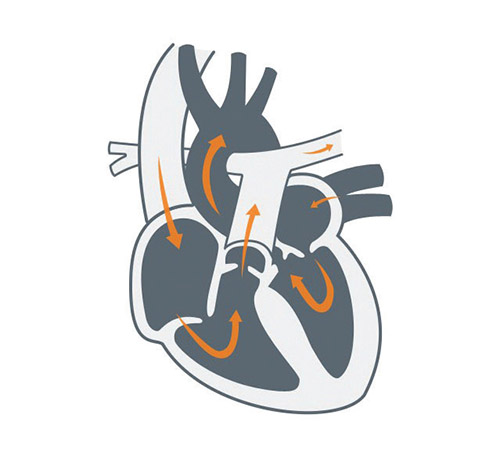
Atrial fibrillation, or AFib, is a cardiovascular disease that causes abnormal heart rhythm. AFib is caused by a combination of factors, but principally its development is attributed to overactive electrical signals from the top chambers of the heart. These signals are disorganized, causing the atria to “fibrillate” or “flutter.” A small percentage of AFib is caused by heart valve problems. The most dangerous consequence of atrial fibrillation is stroke—the average person with AFib is about five times more likely to suffer a stroke than someone with a regular heartbeat, with a risk ranging from two to 20 percent a year.
Most people with AFib are treated with a blood-thinning medication such as warfarin (brand name Coumadin) to reduce the risk of forming blood clots in the heart that cause a stroke. For some, though, these medications cannot be taken long term. Until recently, there was no FDA-approved alternative to blood thinners.
Now there is: a tiny device implanted into the heart itself to block off the area where most of these clots form. It’s called the Watchman. The team of David Dobesh, MD, cardiac electrophysiologist; Constantinos Costeas, MD, director of Cardiac Electrophysiology at Saint Barnabas Medical Center; and Susan Simandl, MD, director of the Saint Barnabas Medical Center Echocardiography Laboratory, implanted the first four of them at the medical center in January. “There is long-term data showing that the Watchman is equivalent to or superior to using Coumadin,” Dr. Dobesh says. “It reduces the risk of stroke without the increasing risk of internal bleeding from blood thinners. It’s a game changer in how we treat this disease.”
The reason AFib can lead to stroke is because it decreases the heart’s pumping capacity in the top chambers, the atria. When blood isn’t pumped out efficiently, blood cells can pool in a part of the heart’s top left chamber called the left atrial appendage (LAA), where it forms clots that can travel to the rest of the body, including the brain.
More than 90 percent of the clots that cause a stroke in patients with this type of AFib come from the LAA. “The main preventive therapy is blood thinners, but for many patients these are not suitable,” Dr. Dobesh says. They can cause bleeding in the gastrointestinal or urinary tracts, or lead to excessive surface bleeding and bruising, especially in the elderly, who make up a substantial portion of those with AFib. Those with other health conditions that raise the risk of bleeding, such as kidney or liver disease, or blood disorders, are also poor candidates for blood thinners. “Millions of people in the United States have AFib, so a large number of people are at risk,” he says.
For them, the Watchman may be the answer. The device is less than the size of a quarter. It is composed of a self-expanding, nickel-titanium frame, with a polyester fabric cover. To implant it, the surgeon makes a small cut in the upper leg and inserts a catheter, similar in many ways to procedures to implant a cardiac stent. In this case, the doctor guides the Watchman into the LAA. It expands to block off the LAA, and the heart grows its own new tissue over the device over the next 45 days to create a permanent seal, preventing blood from pooling and forming clots there.
The LAA has no known role in normal heart function; it is a vestigial appendage, much like the appendix. “In fact in the original Grey’s Anatomy text it is called the left atrial appendix,” Dr. Dobesh says. “It plays a role in fetal heart development, but you don’t need it after birth.”
The procedure is done under general anesthesia and takes about an hour. Patients commonly stay in the hospital overnight and leave the next day. “The recovery is very quick, and most patients will be back to normal that week,” Dr. Dobesh says. Patients are required to remain on blood thinners for 45 days, until the Watchman has permanently sealed the LAA. An echocardiogram will be performed to make sure the device is working properly. The device is permanent, and never needs to be replaced.
Patients will need to take a different medicine called clopidogrel (known by the brand name Plavix) and aspirin for six months. After six months they are encouraged to continue aspirin on an ongoing basis. A very small number of patients may be encouraged to keep taking blood thinners long term, Dr. Dobesh says, but more than 90 percent of patients can stop taking the drug.
What’s more, those patients will no longer need regular blood tests or to restrict their eating and drinking habits, as is required when on some blood thinners. More than 20,000 Watchman procedures have been performed worldwide since 2005, with more than 10 years of clinical trials and registry data proving its safety and efficacy. It’s the only device of its kind approved by the FDA for reducing stroke risk in people with AFib not caused by heart valve problems.
To learn more about Watchman or cardiac services at Saint Barnabas Medical Center, please call 973-322-5244 or visit rwjbh.org/heart.











